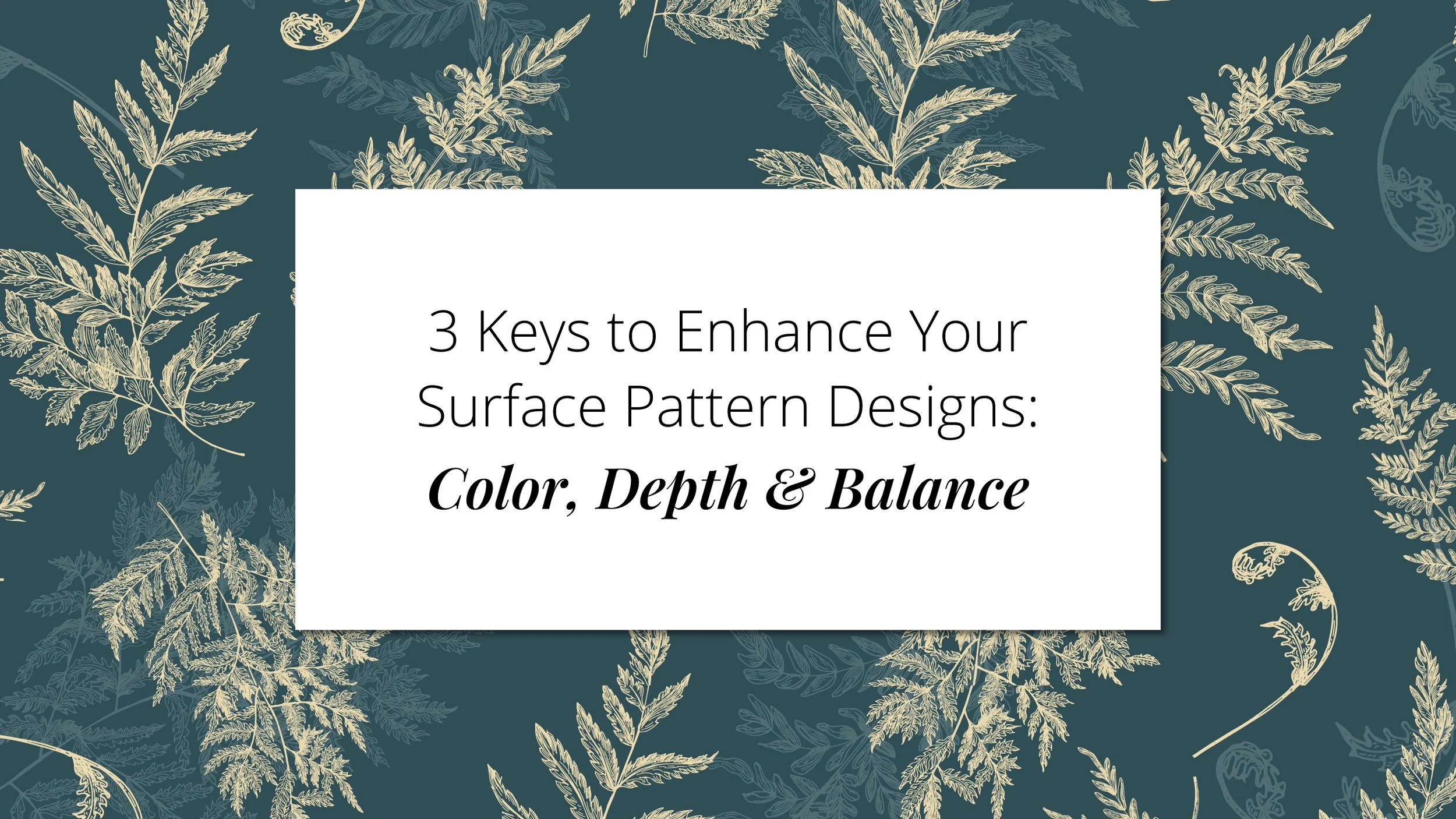3 Keys to Enhance Your Surface Pattern Designs
Last week, we covered three effective strategies to improve your surface pattern designs: doubling the size of your repeat box, turning your repeat into a half drop, and adding a background texture. Now let’s take things even further and explore how color, depth and balance enhance your work. Each of these could be a masterclass in and of itself so keep reading and let’s dive in.
1. Mastering Color
Color is one of the most powerful tools at a designer’s disposal. It can evoke emotions, convey messages, and make your patterns stand out. Here are some tips to master the use of color in your surface pattern designs:
Understanding Color Theory
Color theory is the foundation of using color effectively. It’s essential to understand the color wheel, complementary colors, and color harmonies. Complementary colors, which are opposite each other on the color wheel, can create vibrant and dynamic contrasts. Analogous colors, located next to each other, offer harmony and can create a soothing effect. Triadic colors, evenly spaced around the color wheel, provide a balanced yet exciting palette.
Choosing a Color Palette
Selecting a color palette for your design involves more than picking your favorite hues. Consider the mood you want to convey. Warm colors like reds, oranges, and yellows can evoke energy and warmth, while cool colors like blues and greens can create a calming effect. Tools like Adobe Color can help you experiment with different palettes and find the perfect combination for your design.
Color Proportions
The proportion of colors used in a design can significantly impact its overall feel. A common strategy is the 60-30-10 rule: 60% of a dominant color, 30% of a secondary color, and 10% of an accent color. This approach ensures a balanced and visually appealing design. For example, in a floral pattern, you might use green as the dominant color for the leaves, pink as the secondary color for the flowers, and yellow as an accent for the flower centers.
Experimenting with Gradients and Transparency
Gradients and transparency can add a modern and sophisticated touch to your designs. Gradients can create a smooth transition between colors, adding depth and interest. Transparency, on the other hand, can be used to layer colors and create a sense of lightness and complexity. Tools like Adobe Illustrator and Procreate offer excellent features for experimenting with these effects.
2. Creating Depth
Depth is a crucial element that can make your surface patterns more engaging and dynamic. Here’s how to add depth to your designs:
Layering
Layering elements within your design can create a sense of depth and dimension. Think about how objects overlap and interact in real life. By mimicking this in your patterns, you can create a more realistic and immersive experience. For instance, layering leaves and flowers in a botanical pattern can give the impression of a lush, dense garden.
Shadow and Highlights
Adding shadows and highlights can enhance the three-dimensional feel of your patterns. Shadows can ground elements and make them appear more tangible, while highlights can bring attention to specific areas and create a sense of light source. Use subtle gradients and soft brushes to achieve these effects without making your design look too harsh.
Textures
Incorporating textures can also add depth and richness to your patterns. Textures can be created digitally or scanned from physical materials. They can range from subtle paper grain to bold, tactile surfaces. Adding texture can give your designs a more organic and handcrafted feel. For instance, a slight watercolor texture can soften the look of a pattern and add a unique artistic touch.
Perspective
Using perspective can make elements in your pattern appear closer or farther away, adding to the overall sense of depth. For example, elements drawn in a smaller scale can appear to be in the background, while larger, more detailed elements can seem to be in the foreground. This technique can create a more dynamic and visually interesting composition.
3. Achieving Balance
Balance is a fundamental principle in design that ensures your pattern is harmonious and pleasing to the eye. Here are some strategies to achieve balance in your surface pattern designs:
Symmetrical vs. Asymmetrical Balance
Symmetrical balance involves mirroring elements on either side of a central axis, creating a formal and orderly design. Asymmetrical balance, on the other hand, involves arranging elements of different sizes, colors, or shapes in a way that still feels balanced. Both approaches have their merits, and the choice depends on the desired effect. Symmetrical designs can be calming and stable, while asymmetrical designs can be more dynamic and interesting.
Visual Weight
Understanding visual weight can help you balance your designs more effectively. Elements with darker colors, larger sizes, or complex shapes tend to have more visual weight. Balancing heavier elements with lighter ones can create a more harmonious design. For example, a large dark element on one side of the pattern can be balanced with several smaller, lighter elements on the other side.
Repetition and Rhythm
Repetition of elements can create a sense of rhythm and cohesion in your design. However, it’s important to vary the repeated elements slightly to avoid monotony. Introducing subtle variations in color, size, or orientation can keep the design interesting while maintaining a cohesive look. For instance, repeating a motif in different sizes or colors can create a dynamic yet unified pattern.
Focal Points
Creating focal points can guide the viewer’s eye and add interest to your design. Focal points can be achieved through the use of contrasting colors, unique shapes, or strategic placement. For example, a brightly colored flower in the center of a floral pattern can draw attention and serve as a visual anchor.
Elevating your surface pattern designs involves a blend of creativity, technical skill, and a keen eye for detail. By mastering color, creating depth, and achieving balance, you can take your designs to the next level. Remember, practice is key. Continuously experimenting with new techniques and learning from other designers can inspire you and help you grow as a designer.
Happy designing!
Join me LIVE this Wednesday, June 5 at noon pacific / 3pm eastern for my weekly Wednesday broadcast about art, creativity and surface design. I’ll be live on my Facebook business page and on my YouTube channel. A very special guest, Alicia Berberich, is joining me to talk about Mindset and quieting those negative voices in your head that hold you back. See you there.
xo,
Anne
P.S. Don’t forget to grab my free ebook on the 7 Ways to Share Your Art in Surface Pattern Design. Click HERE to grab it.
It’s Never Too Late to Create®
If you enjoyed this blog please share it with your friends and family. Click your favorite social platform below. And join my email list for weekly creative inspiration and an invitation to our private Facebook group, Anne’s Art Club.
MEET ANNE
Hi…I’m Anne!
My creative inspiration comes from a lifetime of observation. I grew up in Paris on the Place St. Sulpice and walked to school through the Luxembourg gardens. And that was only the beginning… Learn more by watching the video on my About page.




